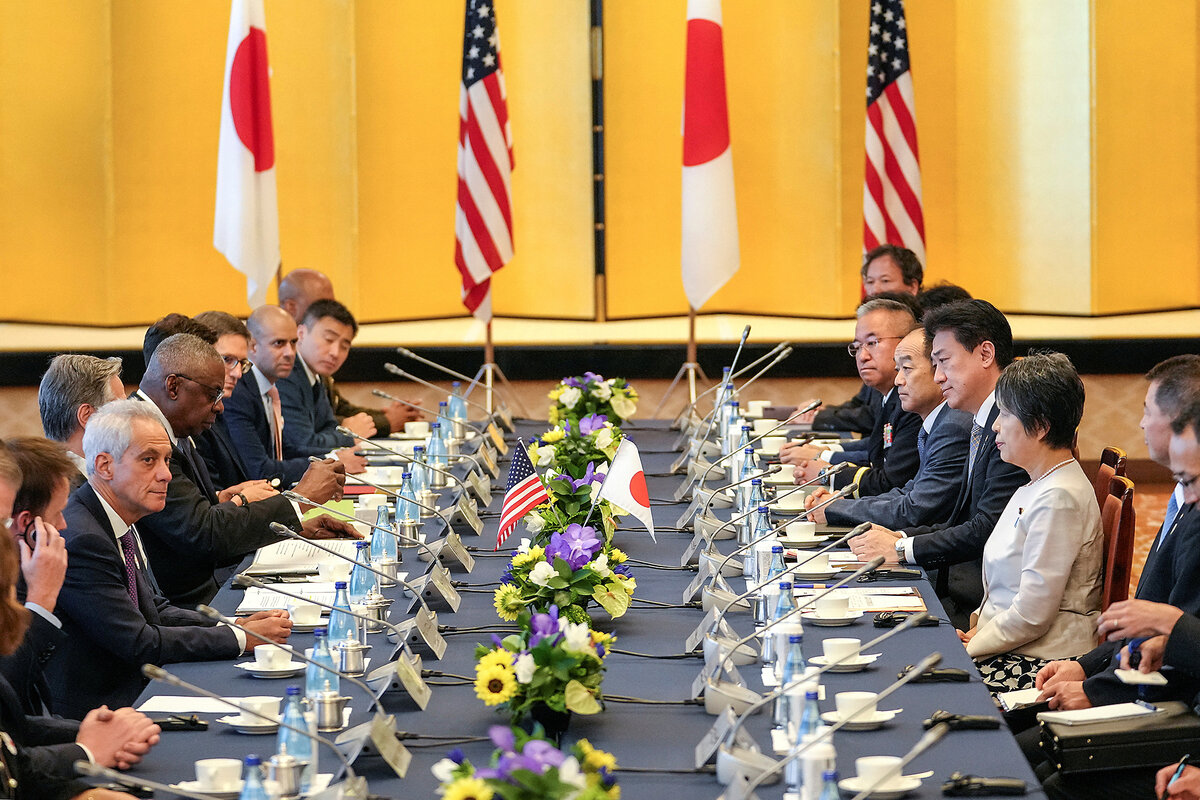China, North Korea draw US attention even as Mideast conflict escalates
Loading...
| LONDON
Their boss had just abandoned his presidential campaign. Violence was raging in the Middle East. Russia’s invasion forces were making fresh advances in eastern Ukraine.
Yet U.S. Secretary of State Antony Blinken and Defense Secretary Lloyd Austin went ahead with overlapping visits this week to the other side of the world, underscoring the importance of what’s become an urgent foreign policy priority for Joe Biden’s presidency.
The focus is Asia.
Why We Wrote This
Fears of a wider regional conflict in the Middle East and fresh incursions by Russia into Ukraine dominate headlines. But a less-noticed foreign policy push in Asia reveals American priorities to contain China and North Korea.
The aim: to assemble the strongest possible regional bulwark against an increasingly ambitious and assertive China and a nuclear-armed North Korea that has been drawing closer to Russia.
There’s also been an emphasis on building up a range of diplomatic, economic, and security partnerships robust enough to outlast President Biden’s time in office. That’s in recognition of the fitful progress of the Obama administration’s high-profile “pivot toward Asia” before it was disowned by President Donald Trump a few years later.
Mr. Biden seems hopeful his “Indo-Pacific strategy” will have greater staying power, even if Mr. Trump regains the White House.
Both the reach of his administration’s regional partnerships, and the reasons for his confidence, have been on display during this week’s travels by secretaries Blinken and Austin.
They’ve held meetings with counterparts from close allies Japan and South Korea, where U.S. troops have been based for decades, and the Philippines. Mr. Blinken also joined a meeting of the Quadrilateral Security Dialogue, or the Quad, including the U.S., Japan, Australia, and assertively nonaligned India. He visited Communist-ruled Vietnam, with which Washington has also been forging closer ties.
They are among a number of countries in the region with their own reasons to share U.S. security concerns. Those include the prospect of Russia helping North Korea with more powerful missiles; and China acting on its determination to “reunify” the island democracy of Taiwan, by force if necessary, and taking further aggressive action to press its widely contested claim to most of the vast South China Sea.
Key U.S. allies also seem increasingly ready to take steps to put safeguards in place.
Japan and South Korea
Nowhere has that been more evident than in Japan, where the U.S. Cabinet secretaries formalized a major upgrade in military coordination.
In the shadow of World War II, Japan adopted a pacifist constitution limiting its military to a modestly funded self-defense force. Yet 18 months ago, the government unveiled plans to strengthen its armed forces and ramp up defense spending to 2% of its gross domestic product within the next five years.
That figure, given the size of the country’s economy, would give Japan the world’s third-largest defense budget, behind only the U.S. and China.
In Tokyo this week, the U.S. envoys announced plans to expand U.S. military headquarters in Japan, and place it under a three-star general, in order to coordinate with Japan’s own recently unified military command. They also discussed plans for possible coproduction of weapons.
The Tokyo visit also showcased a dramatic change involving another key ally, South Korea.
Seoul’s relations with Japan have long been scarred by Japan’s harsh colonial occupation of Korea. But last summer, at a three-way summit at Camp David, Mr. Biden presided over a rapprochement between Korea and Japan that includes a framework of regular military consultations and joint exercises.
South Korea’s defense minister joined this week’s talks in Tokyo, the first such official visit in some 15 years, and met with Japan’s defense minister and Mr. Austin.
The Philippines
Political change was evident, too, on a Blinken-Austin visit to the Philippines.
There, President Ferdinand Marcos Jr.’s predecessor, Rodrigo Duterte, had distanced himself from the U.S. in favor of closer ties with China. Yet since assuming office two years ago, Mr. Marcos has reinforced his country’s alliance with Washington, a move bolstered this week by the announcement of $500 million in new U.S. military assistance.
None of this necessarily means the U.S. strategy will achieve its ultimate aim: to deter Chinese or North Korean aggression without the need for direct military confrontation, something both Washington and its regional partners want to avoid.
But this week’s diplomacy will have reinforced confidence among U.S. regional partners that America’s heightened emphasis on potential security threats in Asia will prove lasting.
That’s partly because of a rare bipartisan consensus in Washington that China has become America’s main 21st-century rival power.
And it’s partly because of the way Mr. Biden’s Indo-Pacific partnerships have developed, making them less vulnerable to Mr. Trump’s criticism, as president, of allies he believed weren’t pulling their weight.
But the fact Mr. Blinken and Mr. Austin jetted off to Asia also answered another important question that bedeviled the Obama administration’s Asian pivot: whether it risked abandoning important, long-standing U.S. commitments elsewhere.
That’s inevitably going to be an issue, if only because even the U.S. lacks the military reach and diplomatic bandwidth to be fully engaged everywhere, all at once.
But with major military conflicts in both Europe and the Middle East, the political significance of America’s top foreign policy and security ministers traveling to Asia will not have been lost on its partners in the Indo-Pacific.
Nor, they’ll hope, on China and North Korea.








